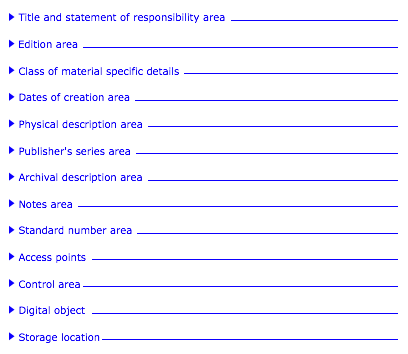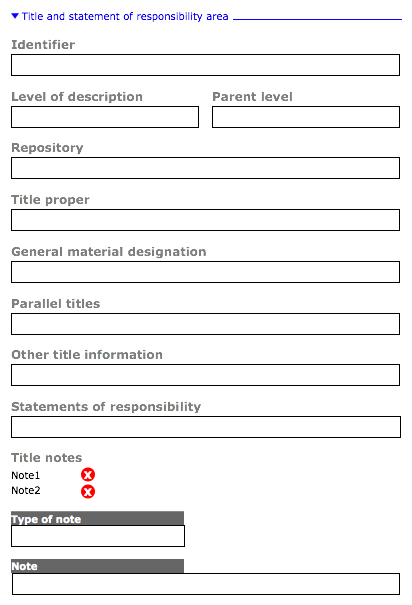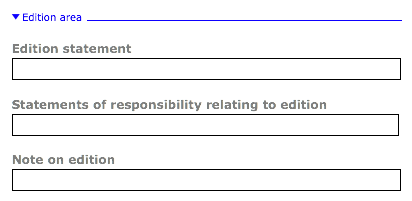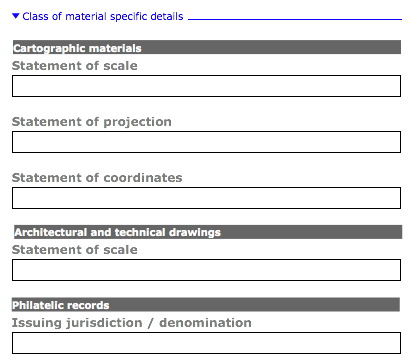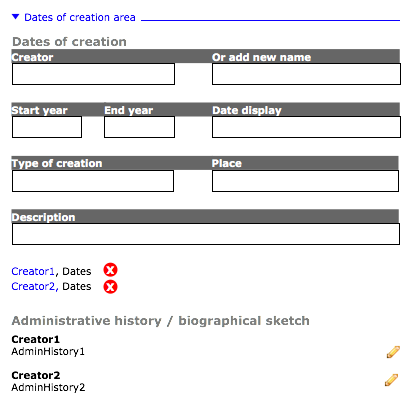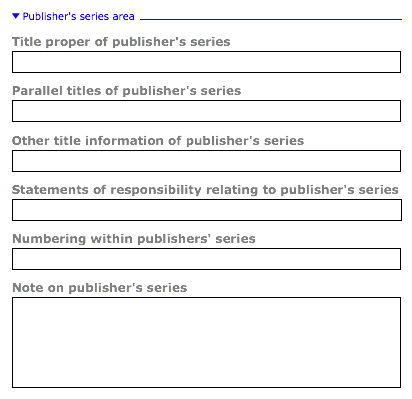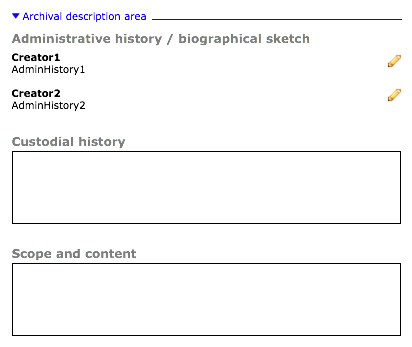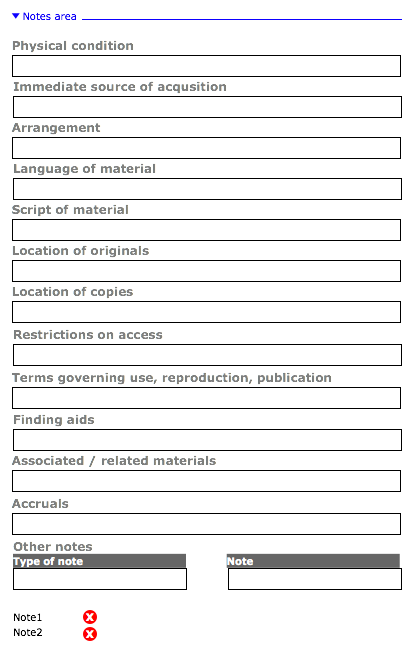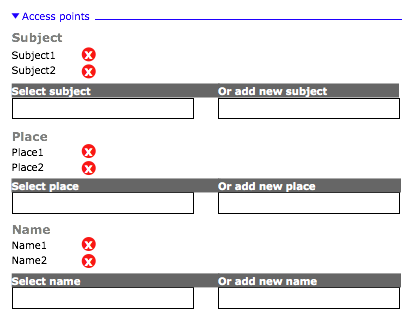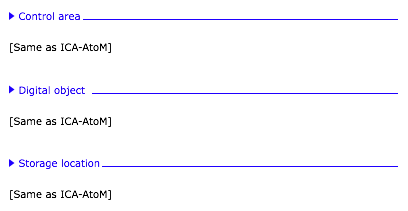BCAUL Pilot project: Classic RAD template
Main Page > Development > Development/Projects > Development/Projects/BCAUL Pilot > Development/Projects/BCAUL Pilot/Templates > Classic RAD
Overview
The purpose of this template is to provide an interface that mirrors as closely as possible the Canadian Rules for Archival Description (RAD). Field labels correspond to RAD element names and are organized into divisions based on RAD's areas of description, with additional divs to handle Qubit-required fields / implementations that have no RAD equivalent.
The same template is used across all levels of description. RAD, however, includes several areas of description and elements that apply only at the item-level or only to specific media. Some of the fields displayed will accordingly be of only marginal relevance to typical, aggregate-level description.
Divs based on RAD areas:
- Title and statement of responsibility area
- Edition area
- Class of material specific details area
- Dates of creation area
- Physical description area
- Publisher's series area
- Archival description area
- Notes area
- Standard number area
- Access points
Additional Qubit-required divs:
Title and statement of responsibility area
This div corresponds to RAD area 1.1, but includes several Qubit-required fields that have no RAD analog: Identifier, Level of description, Parent level, Repository.
Where ISAD(G) has only 1 title element (3.1.2), RAD breaks titles down into 5 elements: Title proper (1.1B), General material designation (1.1C), Parallel titles (1.1D), Other title information (1.1E), and Statements of responsibility (1.1F - applies only at item-level). These elements are then concatenated into a single title statement, with punctuation rules to distinguish the various components. RAD also includes 6 separate Note area elements for additional narrative information relating to titles (1.8B1 - 1.8B6)
Qubit implements this RAD area as follows:
- Title and Parallel titles map to fields in the information_object table.
- General material designation, Other title information, and Statements of responsibility map to Qubit properties (records in the property table).
- All of the element are combined and structured by RAD punctuation rules in the Title returned for display purposes.
This div also includes a section for adding RAD notes (1.8B1 - 1.8B6) relating to title elements (map to records in the note table).
Value lists
The following fields have drop-down value lists:
- Level of description (get values from "Levels of description" taxonomy).
- Repository (get names of all records in repository table).
- General material designation (get values from "material type" taxonomy).
- Type of note (get values from "RAD title notes" taxonomy).
Edition area
This div corresponds to RAD area 1.2, which applies only at the item-level for statements relating to multiple versions of an item. The area contains 2 elements: Edition statement (1.2B) and Statements of responsibility relating to edition (1.2C). Neither of these elements have an ISAD(G) analog.
Qubit implements this RAD area as follows:
- Edition statement maps to a Qubit field (information_object::edition).
- Statements of responsibility relating to edition maps to a Qubit event (record in the event table); there can be multiple statement.
- Data from both elements are combined and structured by RAD punctuation rules in the Edition returned for display purposes.
This div also includes a field for adding a RAD note relating to edition (1.8B7 - maps to a record in the note table).
Class of material specific details area
This div corresponds to RAD area 1.3, which applies only to certain special media: catrographic materials (5.3 Mathematical data area – 3 elements), architectural and technical drawings (6.3 Scale area – 1 element), and philatelic records (13.3 Issue data area – 2 elements). None of these elements have direct ISAD(G) or Qubit analogs.
Qubit implements this RAD area by mapping each element to Qubit properties (records in the property table).
Note that with philatelic records, 2 RAD elements (Jurisdiction and Denomination) have been combined into a single field, leaving it to the user to apply RAD punctuation.
- This is because at aggregate levels of description, there is often a one-to-many relation between these elements.
- E.g. a descriptive unit contains stamps of several denominations from one jurisdiction, "Canada : 4 cents, 40 cents".
Dates of creation area
This div corresponds to RAD area 1.4, Dates of creation, publication, distribution, etc. Where ISAD(G) has 1 date element (3.1.2), RAD has 5: Dates of creaton (1.4D), Place of publication, distribution, etc (1.4C), Name of publisher, distributor, etc. (1.4D), Statement of function of publisher, distributor, etc (1.4E), Date of publication, distribution, etc (1.4F), and Place of manufacture, name of manufacturer, date of manufacture (1.4G). In addition, there are 2 RAD note elements (1.8B8 and 1.8Ba) that permit distinguishing dates of creation vs dates of accumulation.
Note, however, that RAD presents the date elements in terms of an either-or:
- Either use 1.4B (for aggregate-level descriptions or at the item level for unpublished material);
- Or use 1.4C-G (for published items).
RAD formats 1.4C-G as a single statement with punctuation rules for separatng elements.
Qubit implements dates as creation events linking actors (corporate bodies, persons, families) to bodies of material over periods of time.
- There can be multiple creation events of different types (e.g. dates of creation, accumulation, publication etc).
- In this section the user not only enters date ranges, but at the same time establishes the link between the archival materials and the creator(s).
- If the creator name is left blank, the description inherits creator information from the parent record.
Because this div is used for both date ranges and for establishing creator relationships, the Administrative history / biographical sketch element is included here, as well as its more RAD-compliant location in the Archival description area.
- The Admin history / bio sketch field actually resides in the related authority record.
- To edit, the user must click the pencil icon, which routes them to the authority record.
This div also includes a section for adding RAD notes specifically relating to dates (1.8B8 - map to records in the note table).
Value lists
The following fields have drop-down value lists:
- Type of creation (get values from "Event types" taxonomy).
Physical description area
This div corresponds to RAD area 1.5. Where ISAD(G) has 1 element (4.5.1 Extent and medium), RAD has 4: Extent of descriptive unit (1.5B), Other physical details (1.5C), Dimensions (1.5D), and Accompanying material (1.5E). Note, however, that in RAD the elements are concatenated into to a single statement, using punctuation rules to separate elements. Each description can have then multiple statements.
E.g.:
- 16 photographs : b&w ; 6 x 6 cm + 1 identification key
- 82 maps : col. ; 55 x 79 cm or smaller, on sheets 73 x 90 cm or smaller + 1 index map
Qubit implements this RAD area by mapping all RAD elements to a single field in the information_object table (extent_and_medium).
- This leaves it to the user to structure the data according to RAD punctuation rules.
Publisher's series area
This div corresponds to RAD area 1.6. It applies only at the item level for information relating to the publisher's or artist's series to which an item belongs. It contains 5 elements: Title proper of publisher's series (1.6B), Parallel titles of publisher's series (1.6C), Other title information of publisher's series (1.6D), Statement of responsibility relating to publisher's series (1.6E), and Numbering with publisher's series (1.6F). None of these elements have ISAD(G) or Qubit equivalents.
Qubit implements this RAD area by mapping each element to Qubit properties (records in the property table).
This div also contains a field for entering the RAD note (1.8B10) relating to publisher's series.
Archival description area
This div corresponds to RAD area 1.7 which contains 3 elements: Administrative history / biographical sketch (1.7B), Custodial history (1.7C), and Scope and content (1.7D). Each of these has clear ISAD(G) equivalent.
Qubit implements this RAD area as follows:
- Map Scope and content and Custodial history to fields in the information_object table.
- Map Administrative history / biographical sketch to a field in the actor table.
The admin history data resides in the creator's authority record. Qubit establishes the relation between the archival description and the creator's authority record through the event table, linking an actor to a body of materials (information object) over a period of time. This same method is used to store date ranges generally and for this reason, the Admin history field is also included in the Dates of creation area div.
- To edit the admin history / bio sketch, the user must click the pencil icon (takes them to the related authority record for editing).
- To add / change the creator, the user must return to the Dates of creation area and add a new entry (creation event) and / or delete the existing one.
Notes area
This div corresponds to RAD area 1.8. RAD includes 30 elements as distinct types of notes in this area. A number of these have analogs in ISAD(G) where they are treated as descriptive elements in their own right rather than "notes".
Qubit implements this RAD area as follows:
- Map those elements (13 in total) that have ISAD(G) analogs to the Qubit fields that represent them in the information_object table.
- Map the remainder to Qubit notes (records in the note table, where the value of the Type field = the name of the RAD note).
- Use a controlled taxonomy (RAD notes) to provide a drop-down list of note types.
Value lists
The following fields have drop-down value lists:
- Language of material (get list of values from Symfony framework).
- Script of material (get list of values from Symfony framework).
- Other notes - type of note ("RAD notes partial" taxonomy).
Standard number area
This div corresponds to RAD area 1.9, which contains only one element: Standard number (1.9B), applicable only at the item level for standard numbers assigned to items by international bodies (e.g. ISBNs, ISSNs).
Qubit implements this RAD area by mapping Standard number to a Qubit property (record in the property table).
Access points
RAD chapter 21 deals with access points. RAD recognizes the following types of access point (see 21.0A3):
- Provenance: name of the person(s), family (ies), or corporate body (bodies) responsible for the creation and/or accumulation and use of the unit being described.
- Author: person(s), corporate body(ies) responsible for the form and intellectual or artistic content of the unit being described, if different from the creator of that unit.
- Other non-subject: e.g. name(s) of custodians, offices held by a person, persons holding office, persons comprising a family, title.
BCAUL supports Name access points. Archives Canada accommodates Subjects in addition to Names.
Qubit implements access points in the RAD template in the same way it does in the ISAD(G) template, i.e. allowing Name, Place and Subject access points with no qualifying "types".
Control area / Digital object / Storage location
These divs contains elements that have no RAD analogs (for record control) or fields required for Qubit-specific implementations (digital object and physical object storage). These can all be implemented in the same way as in the ISAD(G) template.


